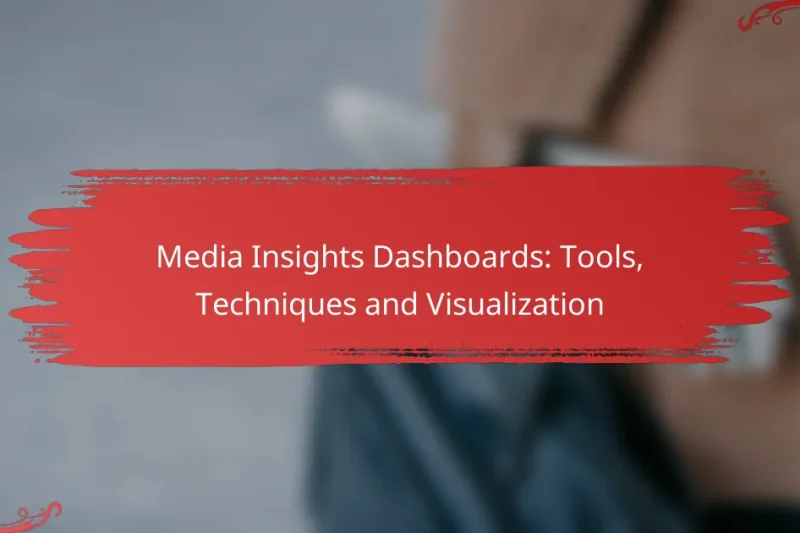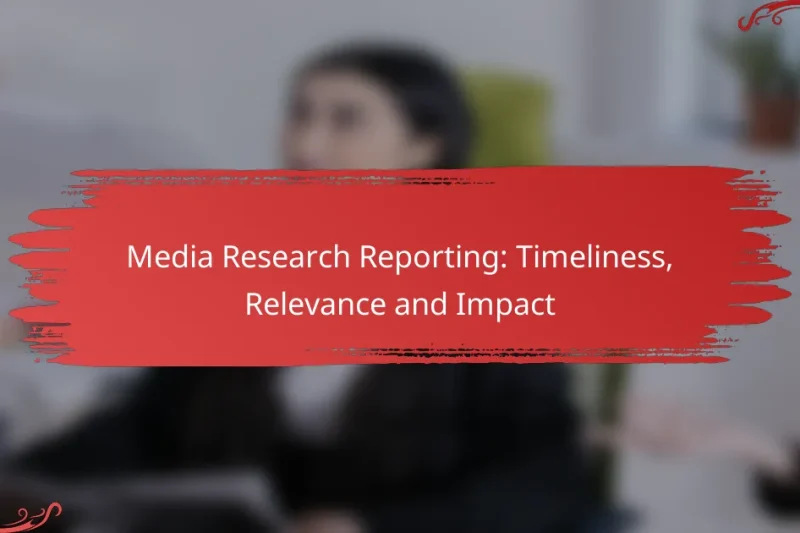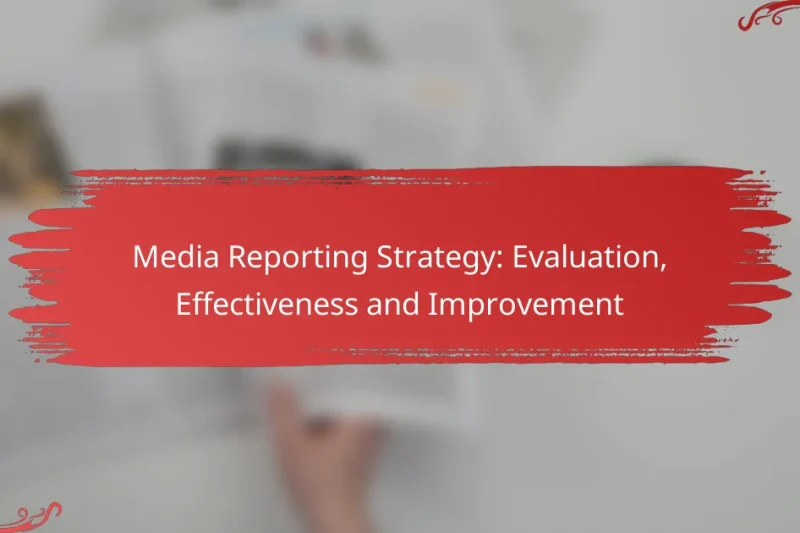Media reports have the potential to engage diverse audience segments by customizing content to align with … Media Reports: Tailoring for Audience Segments and EngagementRead more
Reporting Insights in Media Research
Reporting insights in media research is essential for analyzing data that informs strategic decisions. By understanding audience behavior and preferences, researchers can enhance the effectiveness of media campaigns, ultimately leading to improved engagement and conversion rates.
Media Insights Dashboards: Tools, Techniques and Visualization
Media insights dashboards are essential tools for organizations looking to analyze media performance and track key … Media Insights Dashboards: Tools, Techniques and VisualizationRead more
Media Research Reports: Effectiveness, Structure and Stakeholder Engagement
Media research reports play a crucial role in advertising by delivering valuable insights that optimize campaigns … Media Research Reports: Effectiveness, Structure and Stakeholder EngagementRead more
Media Insights Presentation: Best Practices and Audience Engagement
Creating engaging media insights presentations requires a strategic approach that combines effective visuals, storytelling, and interactive … Media Insights Presentation: Best Practices and Audience EngagementRead more
Media Research Reporting: Storytelling Techniques and Impact
Effective storytelling techniques in media research reporting play a crucial role in enhancing audience engagement and … Media Research Reporting: Storytelling Techniques and ImpactRead more
Media Research Reporting: Timeliness, Relevance and Impact
Media research reporting is essential for enhancing advertising effectiveness by delivering insights that guide targeting and … Media Research Reporting: Timeliness, Relevance and ImpactRead more
Media Reporting Strategy: Evaluation, Effectiveness and Improvement
Media reporting strategies play a crucial role in shaping public perception and understanding of news. By … Media Reporting Strategy: Evaluation, Effectiveness and ImprovementRead more
How to leverage reporting insights in media research?
Leveraging reporting insights in media research involves analyzing data to inform strategic decisions. By understanding audience behavior and preferences, researchers can enhance their effectiveness and reach.
Utilizing data analytics tools
Data analytics tools are essential for extracting meaningful insights from large datasets in media research. These tools can help identify trends, measure engagement, and assess the performance of various media channels.
Popular analytics platforms like Google Analytics, Tableau, and Adobe Analytics can provide visualizations and reports that simplify complex data. When selecting a tool, consider factors such as ease of use, integration capabilities, and cost, which can range from free options to several hundred dollars per month.
Implementing audience segmentation
Audience segmentation involves dividing your audience into distinct groups based on shared characteristics, such as demographics, interests, or behaviors. This practice allows for more targeted messaging and content delivery, increasing engagement and effectiveness.
To implement audience segmentation, start by collecting data through surveys, social media analytics, or website interactions. Aim for at least three to five segments to ensure a diverse approach, and regularly review and adjust segments based on evolving audience insights.
Enhancing content strategy
Enhancing your content strategy requires integrating insights from media research to tailor content that resonates with your audience. This can involve adjusting topics, formats, and distribution channels based on what data reveals about audience preferences.
For example, if analytics show that video content performs significantly better than text articles, consider increasing your video production. Regularly test different content types and use A/B testing to refine your approach, ensuring that your strategy remains dynamic and responsive to audience feedback.
What are key metrics for reporting insights?
Key metrics for reporting insights in media research include engagement rates, reach and impressions, and conversion rates. These metrics help evaluate the effectiveness of media campaigns and inform strategic decisions.
Engagement rates
Engagement rates measure how actively audiences interact with content, typically expressed as a percentage. This includes likes, shares, comments, and other forms of interaction relative to total views or impressions.
To calculate engagement rates, divide the total engagements by the total reach or impressions and multiply by 100. For example, if a post receives 200 engagements from 1,000 impressions, the engagement rate is 20%.
High engagement rates often indicate content resonates well with the audience, while low rates may suggest a need for content adjustment. Aim for engagement rates in the low to mid-teens for social media posts to gauge effectiveness.
Reach and impressions
Reach refers to the total number of unique users who see your content, while impressions count how many times the content is displayed, regardless of whether it was clicked. Understanding both metrics is crucial for assessing audience exposure.
For instance, if a campaign reaches 5,000 unique users but generates 10,000 impressions, it indicates that some users viewed the content multiple times. A balanced approach is essential; high impressions with low reach may suggest repetitive exposure without effective engagement.
Monitor these metrics to optimize content distribution strategies. Aim for a reach that is significantly higher than impressions to ensure diverse audience engagement.
Conversion rates
Conversion rates indicate the percentage of users who take a desired action after engaging with content, such as making a purchase or signing up for a newsletter. This metric is critical for evaluating the success of marketing efforts.
To calculate conversion rates, divide the number of conversions by the total number of visitors and multiply by 100. For example, if 50 out of 1,000 visitors convert, the conversion rate is 5%. A good conversion rate typically ranges from 2% to 5%, depending on the industry.
Improving conversion rates can involve optimizing landing pages, refining calls to action, and ensuring that content aligns with audience expectations. Regularly analyze these rates to identify areas for improvement and adjust strategies accordingly.
How can media research improve advertising effectiveness?
Media research enhances advertising effectiveness by providing insights into audience behavior and preferences. This data allows advertisers to make informed decisions about where and how to place their ads, ultimately increasing engagement and conversion rates.
Targeted ad placements
Targeted ad placements involve strategically positioning advertisements where they are most likely to reach the intended audience. By analyzing demographic data, interests, and online behavior, advertisers can select platforms and times that maximize visibility. For instance, placing ads on social media during peak user activity can significantly improve engagement.
Consider using tools that segment audiences based on specific criteria, such as age, location, or purchasing habits. This approach not only enhances relevance but also reduces wasted ad spend, making campaigns more cost-effective.
Optimized ad creatives
Optimized ad creatives are tailored to resonate with the target audience, increasing the likelihood of interaction. This includes using compelling visuals, clear messaging, and appropriate calls to action. Testing different versions of ads can help identify which elements perform best.
Utilize A/B testing to compare variations in ad creatives. For example, changing the color scheme or wording can lead to noticeable differences in click-through rates. Aim for simplicity and clarity to ensure the message is easily understood and appealing.
Real-time performance tracking
Real-time performance tracking allows advertisers to monitor the effectiveness of their campaigns as they unfold. By using analytics tools, advertisers can assess metrics such as click-through rates, conversions, and engagement levels, enabling quick adjustments to improve outcomes.
Establish key performance indicators (KPIs) that align with campaign goals. Regularly review these metrics to identify trends and make data-driven decisions. For example, if a particular ad is underperforming, it may be beneficial to tweak the creative or adjust the targeting parameters immediately.
What tools are essential for media research reporting?
Essential tools for media research reporting include platforms that provide insights into audience behavior, engagement metrics, and data visualization. These tools help researchers analyze performance and make informed decisions based on data trends.
Google Analytics
Google Analytics is a widely used tool that tracks website traffic and user behavior. It provides insights into how visitors interact with content, including page views, session duration, and bounce rates.
To effectively use Google Analytics, set up goals to measure conversions and utilize segments to analyze specific audience groups. Regularly reviewing reports can help identify trends and areas for improvement.
Tableau
Tableau is a powerful data visualization tool that allows users to create interactive and shareable dashboards. It helps in presenting complex data in a clear and understandable format, making it easier to identify patterns and insights.
When using Tableau, focus on connecting to various data sources and utilizing its drag-and-drop interface to create visualizations. Consider using filters and parameters to allow users to explore data dynamically.
Adobe Analytics
Adobe Analytics offers advanced analytics capabilities, focusing on customer journey tracking and segmentation. It provides detailed insights into user behavior across multiple channels, helping organizations understand their audience better.
To maximize the benefits of Adobe Analytics, leverage its real-time data processing and customizable reports. Ensure that you set up proper tagging and tracking to capture relevant data points for analysis.
What frameworks support effective media research reporting?
Effective media research reporting is supported by various analytical frameworks that help structure insights and findings. Two widely used frameworks are SWOT analysis and PEST analysis, which provide distinct lenses for evaluating media environments and strategic options.
SWOT analysis
SWOT analysis focuses on identifying the Strengths, Weaknesses, Opportunities, and Threats related to a media project or organization. This framework helps researchers pinpoint internal capabilities and external factors that could impact media effectiveness.
When conducting a SWOT analysis, consider gathering input from diverse stakeholders to ensure a comprehensive view. For example, a media company might identify strong brand recognition as a strength while recognizing limited digital presence as a weakness. Opportunities could include emerging social media platforms, while threats might involve increasing competition or regulatory changes.
PEST analysis
PEST analysis examines the Political, Economic, Social, and Technological factors affecting the media landscape. This framework is useful for understanding the broader context in which media operates, allowing researchers to anticipate changes and adapt strategies accordingly.
For instance, a PEST analysis might reveal that new government regulations are impacting advertising practices (Political), economic downturns are affecting advertising budgets (Economic), shifting audience demographics are altering content preferences (Social), and advancements in streaming technology are changing consumption habits (Technological). By analyzing these factors, media researchers can make informed recommendations for future initiatives.






